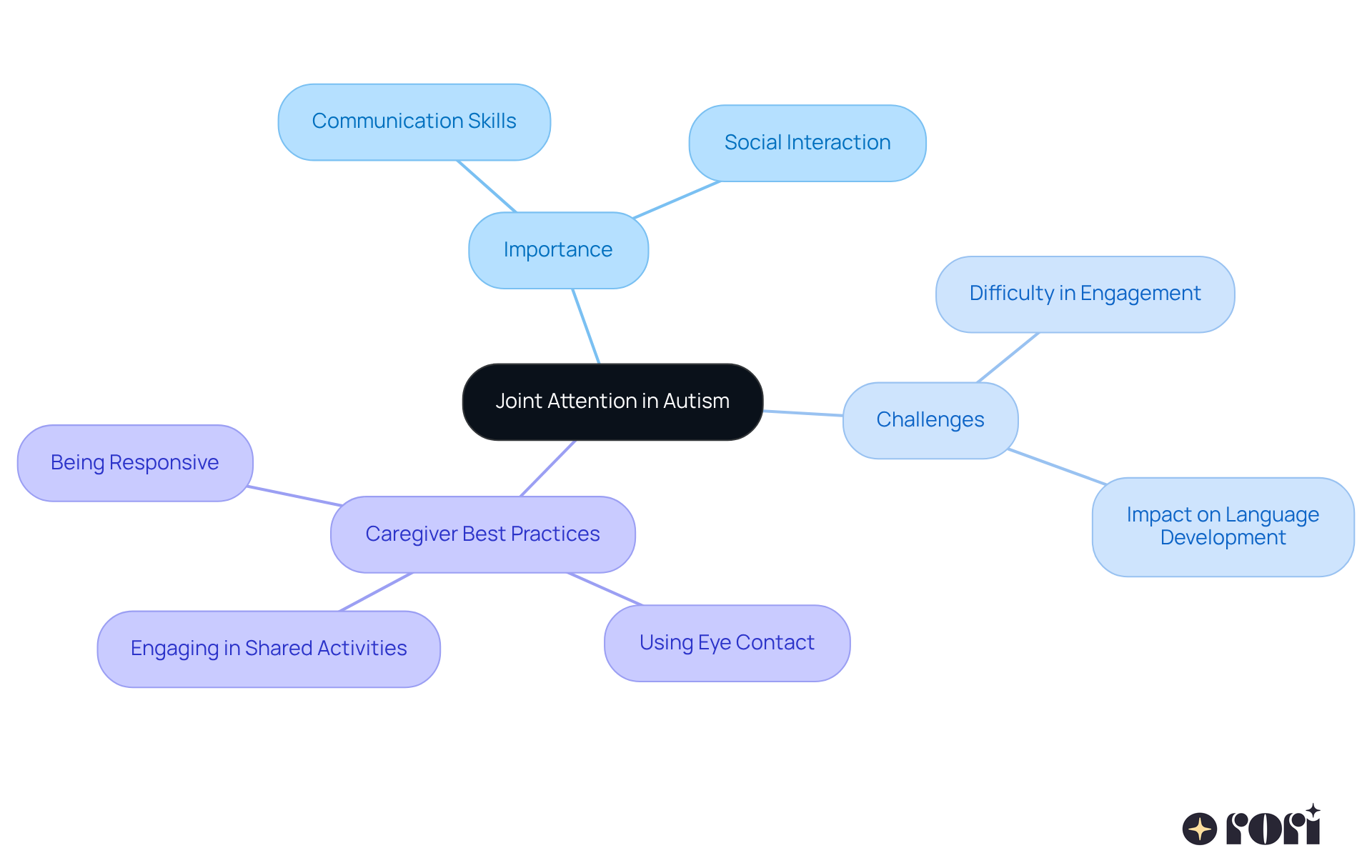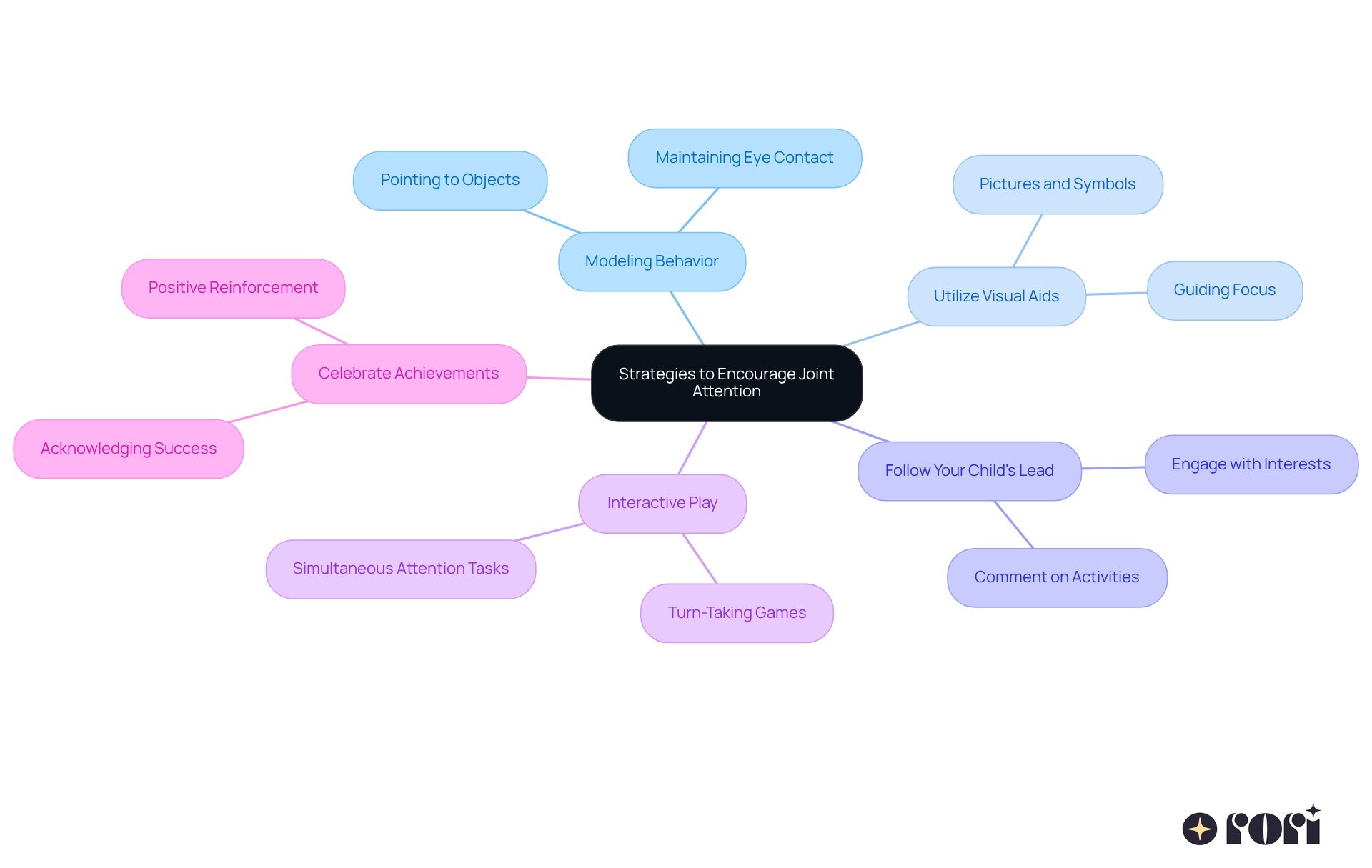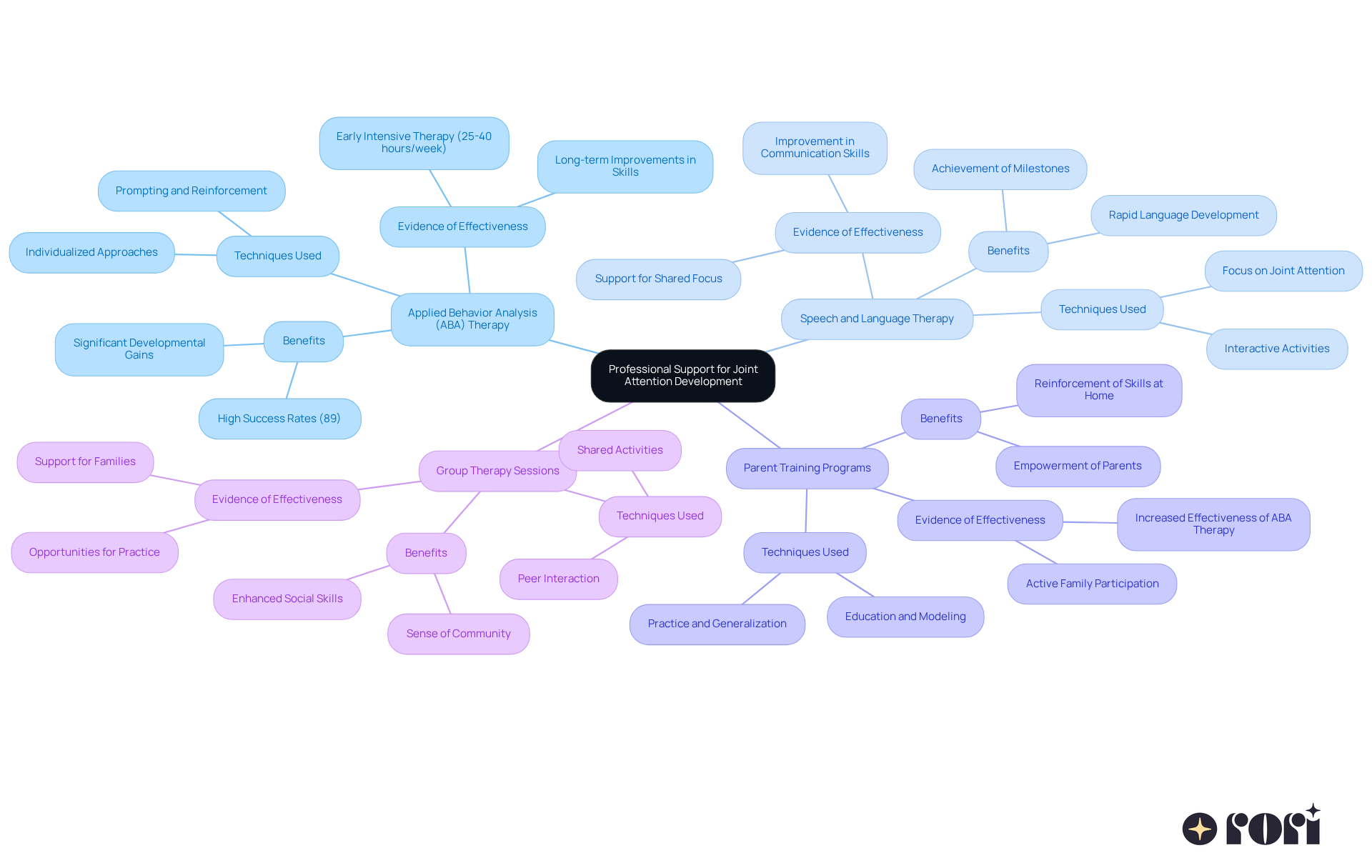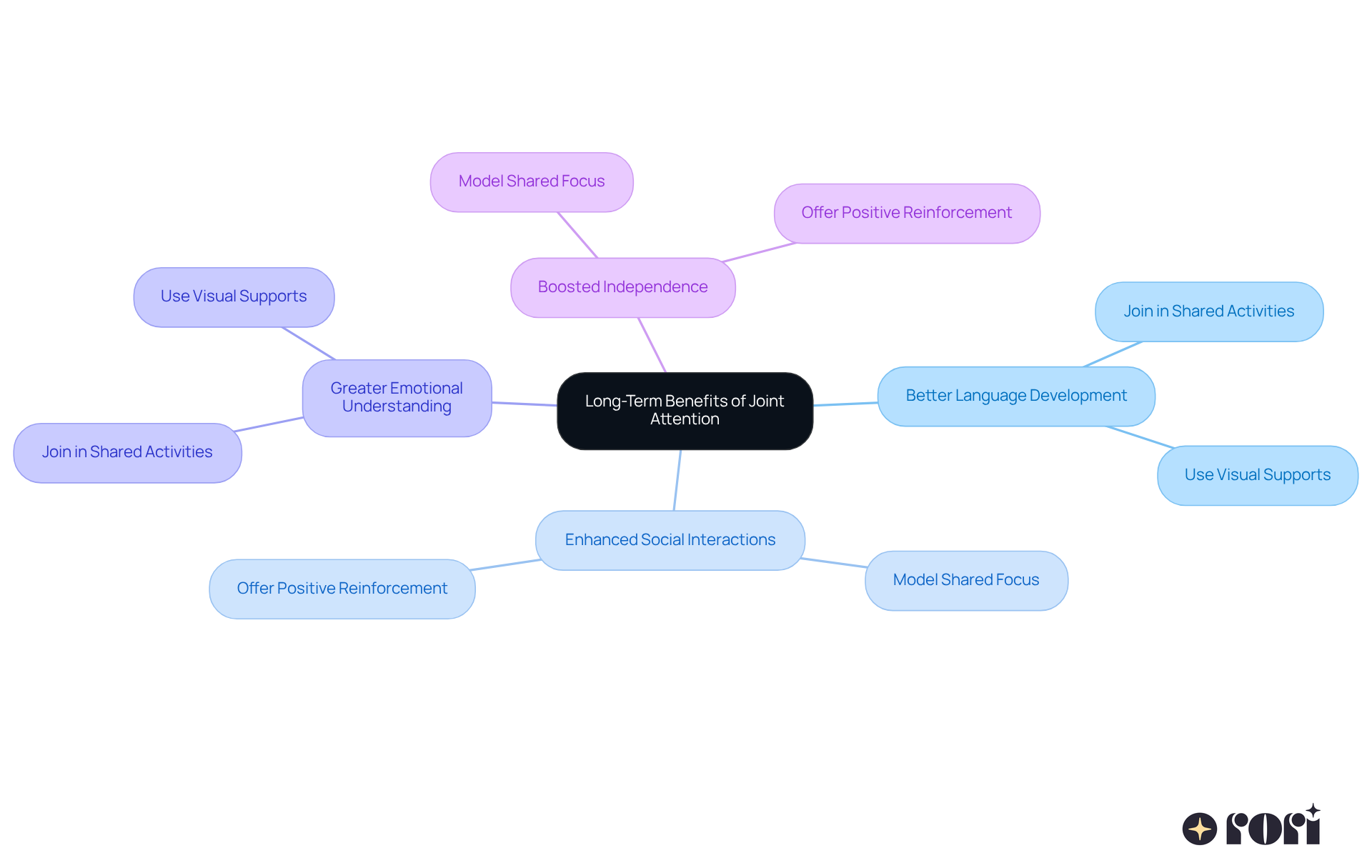Understanding the nuances of joint attention is so important for helping our kids with autism communicate and develop social skills. This ability, which means sharing focus on something - like a toy or an event - can be tricky for many children. It can really affect how they interact with others and how they learn to talk.
By exploring some effective ways to promote joint attention, caregivers can discover amazing developmental benefits. Not only does this enhance a child’s ability to connect with others, but it also creates a nurturing environment that supports their growth. So, how can parents put these strategies into action? Let’s explore this together!
Imagine a moment when your child points at something exciting, and you both share that joy. It’s those little connections that matter! By bridging the gap in communication and social engagement, we can help our children thrive. We’re here to help you every step of the way!
Joint awareness is all about two people sharing their focus on something - like an object or an event. It’s a key part of how we communicate and connect with each other. For kids with autism, though, this shared focus can be a bit tricky. They might find it hard to start or respond to requests for engagement, which can make social interactions and language development more challenging.
Research shows that this ability to share focus usually starts in infancy and is super important for future social and communication skills. For example, kids who are good at collaborating and focusing together often end up with better language skills and social abilities as they grow. So, it’s clear that encouraging shared focus is crucial for helping young ones with autism develop by following best practices for promoting joint attention in autism. It lays the groundwork for meaningful interactions and effective communication.
Now, here’s where caregiver education comes in! When caregivers understand the principles of ABA (Applied Behavior Analysis) and learn the best practices for promoting joint attention in autism, they can truly make a difference. Using eye contact, engaging in shared activities, and being responsive are some of the best practices for promoting joint attention in autism that can boost mutual focus right at home. This informed approach not only leads to better behavioral outcomes but also aligns with therapeutic strategies, making improvements more effective and lasting.
Ultimately, when caregivers feel empowered with knowledge and skills, they can reduce stress and enhance family dynamics. This creates a nurturing environment that supports their child’s development. Let’s explore this together! We’re here to help you every step of the way!

To foster joint attention in children with autism, parents can adopt several effective strategies:
Modeling Behavior: Actively show joint focus by pointing to objects of interest and maintaining eye contact. For example, if you spot a bird outside, point to it and say, 'Look at the bird!' This not only grabs your kid's attention but also teaches them the importance of focusing together.
Utilize Visual Aids: Use visual cues like pictures or symbols to guide your child's focus. Visual aids can help clarify what to pay attention to during interactions, making it easier for them to engage in shared focus.
Follow Your Child's Lead: Tune into your child's interests and engage with them about those topics. If they’re playing with a specific toy, join in and comment on what they’re doing. This approach validates their interests and encourages back-and-forth interaction.
Interactive Play: Get involved in turn-taking games that require shared focus, like stacking blocks or playing with cars. These activities promote simultaneous attention on both you and the task, reinforcing the idea of shared awareness.
Celebrate Achievements: Acknowledge and celebrate moments when your child successfully engages in shared focus. Positive reinforcement can really motivate them to keep using these skills, fostering a sense of accomplishment and encouraging more interaction.
Research shows that shared focus abilities can improve through structured interventions. Studies reveal that kids who participate in parent-implemented interventions (PIIs) show better social skills and communication abilities. By using these strategies, which reflect the best practices for promoting joint attention in autism, parents can play a vital role in their child's development of shared focus, ultimately supporting their overall growth and independence.
Let’s explore this together! We’re here to help you every step of the way!

Getting expert help can really make a difference in applying the best practices for promoting joint attention in autism to boost collaborative focus skills in kids. Parents, let’s take a look at some great options you might consider:
Applied Behavior Analysis (ABA) Therapy: This is often seen as a top-notch, evidence-based approach. ABA therapy focuses on building specific skills, including the best practices for promoting joint attention in autism. Therapists customize their methods to fit each child’s unique needs, using techniques like prompting and reinforcement. Research shows that kids who start early with intensive ABA therapy-typically around 25 to 40 hours a week-often see significant developmental gains, especially in collaborative focus skills.
Speech and Language Therapy: Speech therapists are key players in helping kids improve their communication skills, which are closely tied to shared focus. They use fun, interactive activities that follow the best practices for promoting joint attention in autism and language growth, which are essential for effective communication. Studies reveal that kids who work on their collaborative focus during early intervention often experience rapid language development, hitting those important age-appropriate milestones.
Parent Training Programs: Many organizations offer training for parents, equipping them with the best practices for promoting joint attention in autism to encourage shared focus at home. These programs empower parents to actively participate in their child’s growth, reinforcing learned behaviors and helping them generalize those skills. Evidence suggests that when families are actively involved, it can significantly boost the effectiveness of ABA therapy.
Group Therapy Sessions: Joining group therapy can provide kids with valuable opportunities to practice shared focus in a social environment. Engaging in shared activities and learning from one another through peer interaction are among the best practices for promoting joint attention in autism, which can enhance their social skills and collaborative focus. Plus, group settings often create a sense of community and support for families facing similar challenges.
Let’s explore these options together! Remember, you’re not alone on this journey, and there are resources available to help you every step of the way!

Understanding the long-term benefits of nurturing collaborative focus skills is so important for kids with autism. It can really help improve their social and communication abilities! Research shows that children who have strong joint attention skills often experience some fantastic outcomes:
Better Language Development: When kids can share attention with others, they’re more likely to pick up new words and phrases. This leads to improved communication skills!
Enhanced Social Interactions: Kids who excel in shared focus tend to connect better with peers and adults, which helps build stronger social relationships.
Greater Emotional Understanding: Joint focus helps children read social cues and understand others’ perspectives, which is key for emotional intelligence.
Boosted Independence: As they develop these skills, kids become more adept at navigating social situations on their own, leading to increased confidence and independence.
So, how can caregivers actively apply best practices for promoting joint attention in autism skills? Here are some friendly strategies to try:
By equipping caregivers with these insights and strategies rooted in ABA principles, families can create a supportive environment that maximizes the benefits of these interventions. This approach not only addresses the challenges families with autism face but also nurtures child development through understanding and compassion.
Let’s explore this together! We’re here to help you every step of the way!

Promoting joint attention in children with autism is so important for building their social and communication skills. This shared focus not only boosts interactions between kids and caregivers but also sets the stage for future growth. When parents understand the significance of joint attention and use effective strategies, they can truly make a difference in their child's journey toward independence.
Let’s talk about some best practices for encouraging joint attention! Simple things like modeling behavior, using visual aids, and celebrating those little achievements can go a long way. Engaging with what your child loves and incorporating interactive play helps create those meaningful connections. Plus, don’t forget about professional support! Therapies like ABA and speech therapy can really enhance these strategies, ensuring your child gets the tailored help they need.
Ultimately, promoting joint attention isn’t just about quick wins; it’s about long-term benefits like better language development, improved social interactions, and deeper emotional understanding. By actively participating in your child's growth and using available resources, you can create a nurturing environment that meets their unique needs. Your commitment to fostering joint attention is a powerful step toward unlocking the full potential of children with autism, paving the way for a brighter future filled with meaningful connections and independence.
So, let’s explore this journey together! Remember, you’re not alone in this - we’re here to help you every step of the way!
What is joint attention?
Joint attention is the shared focus between two people on an object or event, which is a key aspect of communication and connection.
Why is joint attention important for children with autism?
Joint attention is crucial for children with autism because it helps them engage in social interactions and facilitates language development, which can be challenging for them.
When does the ability to share focus typically develop?
The ability to share focus usually starts in infancy and is essential for future social and communication skills.
How does joint attention relate to language and social skills?
Children who are adept at collaborating and maintaining joint attention tend to develop better language skills and social abilities as they grow.
What practices can caregivers use to promote joint attention in children with autism?
Caregivers can promote joint attention by using eye contact, engaging in shared activities, and being responsive to their child's needs.
How can caregiver education impact joint attention and child development?
Educating caregivers on the principles of Applied Behavior Analysis (ABA) and best practices for joint attention can lead to better behavioral outcomes and enhance therapeutic strategies, resulting in lasting improvements.
What benefits do empowered caregivers experience?
Empowered caregivers can reduce stress, improve family dynamics, and create a nurturing environment that supports their child's development.